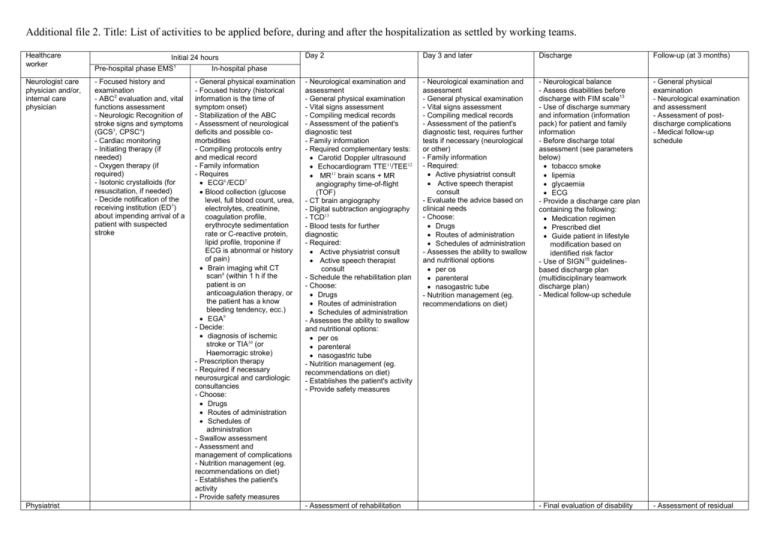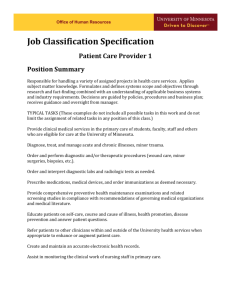Additional file 2
advertisement

Additional file 2. Title: List of activities to be applied before, during and after the hospitalization as settled by working teams. Healthcare worker Initial 24 hours Pre-hospital phase EMS1 In-hospital phase Day 2 Day 3 and later Discharge Follow-up (at 3 months) Neurologist care physician and/or, internal care physician - Focused history and examination - ABC2 evaluation and, vital functions assessment - Neurologic Recognition of stroke signs and symptoms (GCS3, CPSC4) - Cardiac monitoring - Initiating therapy (if needed) - Oxygen therapy (if required) - Isotonic crystalloids (for resuscitation, if needed) - Decide notification of the receiving institution (ED5) about impending arrival of a patient with suspected stroke - Neurological examination and assessment - General physical examination - Vital signs assessment - Compiling medical records - Assessment of the patient's diagnostic test - Family information - Required complementary tests: Carotid Doppler ultrasound Echocardiogram TTE11/TEE12 MR11 brain scans + MR angiography time-of-flight (TOF) - CT brain angiography - Digital subtraction angiography - TCD13 - Blood tests for further diagnostic - Required: Active physiatrist consult Active speech therapist consult - Schedule the rehabilitation plan - Choose: Drugs Routes of administration Schedules of administration - Assesses the ability to swallow and nutritional options: per os parenteral nasogastric tube - Nutrition management (eg. recommendations on diet) - Establishes the patient's activity - Provide safety measures - Neurological examination and assessment - General physical examination - Vital signs assessment - Compiling medical records - Assessment of the patient's diagnostic test, requires further tests if necessary (neurological or other) - Family information - Required: Active physiatrist consult Active speech therapist consult - Evaluate the advice based on clinical needs - Choose: Drugs Routes of administration Schedules of administration - Assesses the ability to swallow and nutritional options per os parenteral nasogastric tube - Nutrition management (eg. recommendations on diet) - Neurological balance - Assess disabilities before discharge with FIM scale13 - Use of discharge summary and information (information pack) for patient and family information - Before discharge total assessment (see parameters below) tobacco smoke lipemia glycaemia ECG - Provide a discharge care plan containing the following: Medication regimen Prescribed diet Guide patient in lifestyle modification based on identified risk factor - Use of SIGN15 guidelinesbased discharge plan (multidisciplinary teamwork discharge plan) - Medical follow-up schedule - General physical examination - Neurological examination and assessment - Assessment of postdischarge complications - Medical follow-up schedule - Final evaluation of disability - Assessment of residual Physiatrist - General physical examination - Focused history (historical information is the time of symptom onset) - Stabilization of the ABC - Assessment of neurological deficits and possible comorbidities - Compiling protocols entry and medical record - Family information - Requires ECG6 /ECD7 Blood collection (glucose level, full blood count, urea, electrolytes, creatinine, coagulation profile, erythrocyte sedimentation rate or C-reactive protein, lipid profile, troponine if ECG is abnormal or history of pain) Brain imaging whit CT scan8 (within 1 h if the patient is on anticoagulation therapy, or the patient has a know bleeding tendency, ecc.) EGA9 - Decide: diagnosis of ischemic stroke or TIA10 (or Haemorragic stroke) - Prescription therapy - Required if necessary neurosurgical and cardiologic consultancies - Choose: Drugs Routes of administration Schedules of administration - Swallow assessment - Assessment and management of complications - Nutrition management (eg. recommendations on diet) - Establishes the patient's activity - Provide safety measures - Assessment of rehabilitation needs - Organizes the rehabilitation plan - Assessment of aphasia Speech therapist Epidemiologist Nurse Head nurse Physiotherapist and/or Occupational therapist - Intravenous access (established) - Assess blood glucose - Acquisition of clinical admissions data - Evaluation: degree of patient autonomy bowel and sphincter functions risk of skin lesions - Put the patient to bed - Ensure the correct position - Ensure the airway flows - Detect vital signs - Monitor (ECG, BP16, O217 saturation) - Monitor temperature - Monitor neurological signs and, awareness - Monitor weight and BMI18 - Sets the daily worksheet - Performs blood collection and check ECG periodically - Active blood glucose profile in case of: hypoglycaemia/hyperglycæmia - Completion nursing record - Applies the bladder catheters if they are medically necessary - Attend the patient for diagnostic tests - Fluid management - Administer therapies - Early and frequent mobilization - Coordinate nursing activities Psychologist Hospital pharmacist Social worker and social family Support staff - Managing the hygiene of the - Plan the patient’s activities for continuation rehabilitation disability with FIM scale14 - Restore the patient’s activities (if needed) - Assessment of residual aphasia - Restore the patient’s activities (if needed) - Acquisition of clinical follow-up data - Assist physicians during the assessments - Assessment of patient and family to prescribed discharge care plan - Assessment of aphasia Plan the patient’s activities rehabilitation - Acquisition of clinical in-hospital data - Evaluation: degree of patient autonomy bowel and sphincter functions risk of skin lesions - Put the patient to bed - Ensure the correct position - Ensure the airway flows - Detect vital signs - Monitor temperature - Monitor (ECG, BP, O2 saturation) - Monitor neurological signs and, awareness - Sets the daily worksheet - Performs diagnostic tests required - Perform blood glucose profile - Completion nursing record - Check the bladder catheter if necessary - Attend the patient for diagnostic tests - Monitor hydration (physiological solution) - Administer the medications - Runs the diet program - Monitor position and mobilization periodically - Acquisition of clinical inhospital data - Evaluation: degree of patient autonomy bowel and sphincter functions risk of skin lesions - Put the patient to bed - Ensure the correct position - Ensure the airway flows - Detects vital signs - Monitor temperature - Monitor neurological signs and, awareness - Sets the daily worksheet - Performs diagnostic tests required - Perform blood glucose profile - Completion nursing record - Check the bladder catheter if necessary - Attend the patient for diagnostic tests - Monitoring hydration (physiological solution) - Administer the medications observing to protocols - Runs the diet program - Monitor position and mobilization periodically - Acquisition of clinical discharge data - Evaluation: degree of patient autonomy bowel and sphincter functions - Provide a discharge nurse care plan with information about: therapy diet prevention of skin lesions compliance to medications pulmonary toile - Coordinate nursing activities - Provide specific care such as: correct position mobilization - Start the physiotherapy program - Assist with treatment of adjustment difficulties and other psychological issues - Supports the choice of drugs - Coordinate nursing activities - Monitor position and mobilization - Keep on the physiotherapy program - Coordinate nursing activities - Plan the patient’s activities for rehabilitation (as a discharge co-ordinator with multidisciplinary teamwork) - Assist with treatment of adjustment difficulties and other psychological issues - Supports the choice of drugs - Assist with treatment of adjustment difficulties and other psychological issues - Assessed depression using a validated simple screening test - Help the patient complete everyday functional activities of daily living - Promotes family involvement in rehabilitation - Restore the patient’s and family activities - Managing the hygiene of the - Managing the hygiene of the - Restore the patient’s activities (if needed) patient - Support other HCW to mobilization and nutrition - Attend the patient for diagnostic tests patient - Support other HCW to mobilization and nutrition - Attend the patient for diagnostic tests patient - Support other HCW to mobilization and nutrition - Attend the patient for diagnostic tests List of abbreviations: 1 EMS: Emergency Mobile Service; 2ABC: Airway, Breathing, Circulation; 3GCS: Glasgow Coma Scale; 4 CPSC: Cincinnati Pre-hospital Stroke Scale; 5ED: Emergency Department; 6ECG: Electrocardiogram; 7 ECD: Echo color Doppler; 8CT scan: Computed tomography; 9EGA: Arterial blood gas analysis; 10TIA: Transient ischemic attack; 10TTE: Trans-thoracic echocardiogram; 11TTE: Trans-esophageal echocardiogram; 12 MR: magnetic resonance; 13TCD: Trans-cranial Doppler; 14FIM scale: Functional independence measure; 15SIGN: Scottish Intercollegiate Guideline Network; 16BP: Blood pressure; 17O2: Oxygen; 18BMI: Body mass Index






